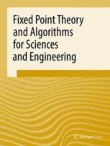Fixed Point Theory and Algorithms for Sciences and Engineering welcomes submissions to the Topical Collection on “Optimization and Real World Applications” edited by Heinz Bauschke (University of British Columbia, Canada), Yunier Bello-Cruz (Northern Illinois University, USA), Radu Ioan Bot (University of Vienna, Austria), Robert Csetnek (University of Vienna, Austria), and Alexander Zaslavski (Israel Institute of Technology, Israel), which covers a wide variety of topics concerning optimization problems and their applications.
These include (but are not limited to)
- smooth and nonsmooth optimization problems (theory and numerical methods),
- monotone operators and nonexpansive mappings,
- real world applications in
- machine learning,
- image/signal processing,
- data classification,
- scientific computing
and other areas.
The collection will close for submissions on December 31st, 2023.
Articles will undergo the journal’s standard peer-review process and are subject to all of the journal’s standard policies, including those pertaining to Collections. Articles will be added to the Collection as they are published.
Click the link below to download the PDF with all information on one page:
TC Optimization and Real World Applications
